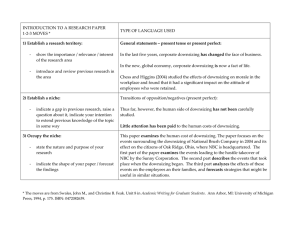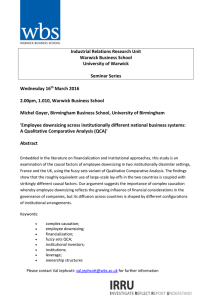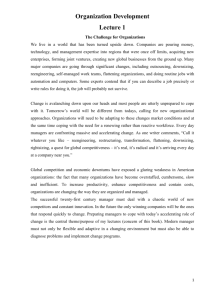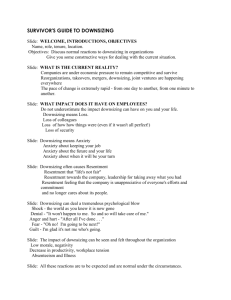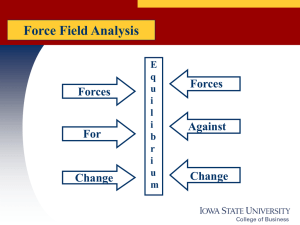Firm Size And The Information Revolution. Does Information Technology Still Lead To Smaller Firms?
advertisement
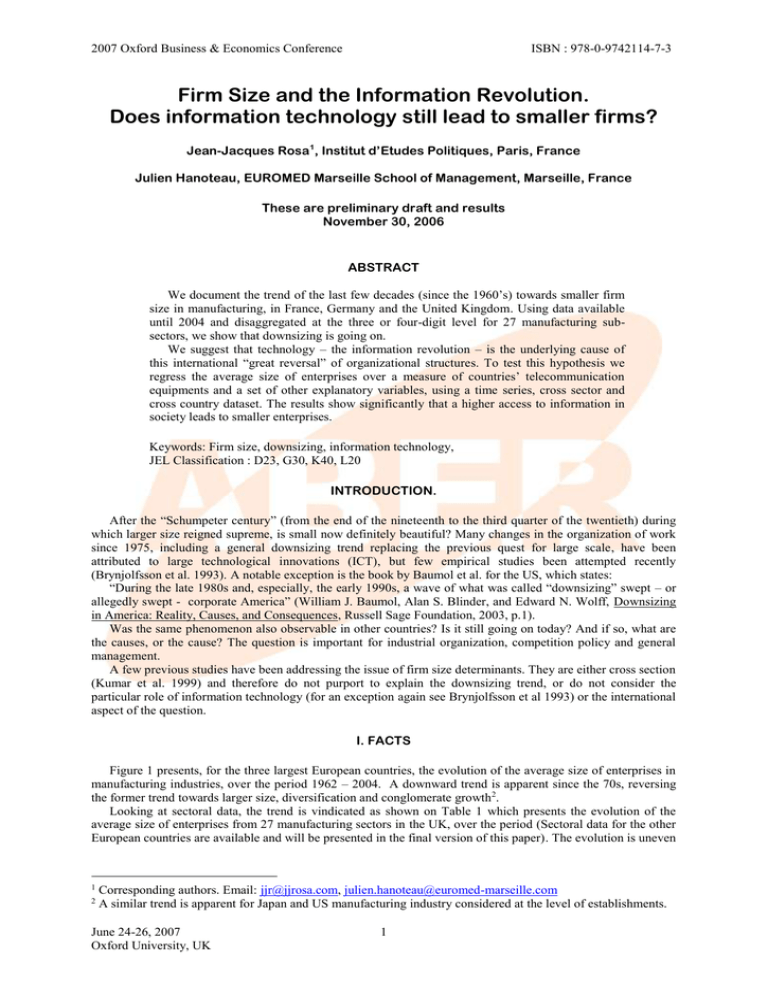
2007 Oxford Business & Economics Conference ISBN : 978-0-9742114-7-3 Firm Size and the Information Revolution. Does information technology still lead to smaller firms? Jean-Jacques Rosa1, Institut d’Etudes Politiques, Paris, France Julien Hanoteau, EUROMED Marseille School of Management, Marseille, France These are preliminary draft and results November 30, 2006 ABSTRACT We document the trend of the last few decades (since the 1960’s) towards smaller firm size in manufacturing, in France, Germany and the United Kingdom. Using data available until 2004 and disaggregated at the three or four-digit level for 27 manufacturing subsectors, we show that downsizing is going on. We suggest that technology – the information revolution – is the underlying cause of this international “great reversal” of organizational structures. To test this hypothesis we regress the average size of enterprises over a measure of countries’ telecommunication equipments and a set of other explanatory variables, using a time series, cross sector and cross country dataset. The results show significantly that a higher access to information in society leads to smaller enterprises. Keywords: Firm size, downsizing, information technology, JEL Classification : D23, G30, K40, L20 INTRODUCTION. After the “Schumpeter century” (from the end of the nineteenth to the third quarter of the twentieth) during which larger size reigned supreme, is small now definitely beautiful? Many changes in the organization of work since 1975, including a general downsizing trend replacing the previous quest for large scale, have been attributed to large technological innovations (ICT), but few empirical studies been attempted recently (Brynjolfsson et al. 1993). A notable exception is the book by Baumol et al. for the US, which states: “During the late 1980s and, especially, the early 1990s, a wave of what was called “downsizing” swept – or allegedly swept - corporate America” (William J. Baumol, Alan S. Blinder, and Edward N. Wolff, Downsizing in America: Reality, Causes, and Consequences, Russell Sage Foundation, 2003, p.1). Was the same phenomenon also observable in other countries? Is it still going on today? And if so, what are the causes, or the cause? The question is important for industrial organization, competition policy and general management. A few previous studies have been addressing the issue of firm size determinants. They are either cross section (Kumar et al. 1999) and therefore do not purport to explain the downsizing trend, or do not consider the particular role of information technology (for an exception again see Brynjolfsson et al 1993) or the international aspect of the question. I. FACTS Figure 1 presents, for the three largest European countries, the evolution of the average size of enterprises in manufacturing industries, over the period 1962 – 2004. A downward trend is apparent since the 70s, reversing the former trend towards larger size, diversification and conglomerate growth 2. Looking at sectoral data, the trend is vindicated as shown on Table 1 which presents the evolution of the average size of enterprises from 27 manufacturing sectors in the UK, over the period (Sectoral data for the other European countries are available and will be presented in the final version of this paper). The evolution is uneven 1 2 Corresponding authors. Email: jjr@jjrosa.com, julien.hanoteau@euromed-marseille.com A similar trend is apparent for Japan and US manufacturing industry considered at the level of establishments. June 24-26, 2007 Oxford University, UK 1 2007 Oxford Business & Economics Conference ISBN : 978-0-9742114-7-3 depending on the sector, but a majority of sectors clearly show a downward trend (Motors vehicles, textiles, paper products, metal products, electrical machinery…). The data point to an overall reduction of the optimal firm size, in the perspective of Stigler’s “survivor principle”, according to which the competition between firms of different sizes sifts out the more efficient enterprises. As explained by Stigler “the survivor technique proceeds to solve the problem of determining the optimum firm size as follows: Classify the firms in an industry by size, and calculate the share of industry output coming from each class over time. If the share of a given class falls, it is relatively inefficient, and in general is more inefficient the more rapidly the share falls” (Chapter 7, The Economies of Scale, in The Organization of Industry, Richard D. Irwin Inc, 1968, p.73, reprinted from The Journal of Law and Economics, Vol. I, 1958). II. THEORY The theory of firm size is a perennial but unsettled subject. Most authors consider that average cost curves in the production function to be flat (Lucas, 1978). But management could be the limiting factor (Friedman, Lucas, Oi, ). Kumar, Rajan and Zingales (1999) distinguish two strands in the literature about the determinants of size: market size and technology. They add human capital and financial openness but the results they find convincing are not especially significant, particularly in their equations including a computer variable (as opposed to the internet use variable of their other equations). Recently Baumol and coauthors pointed to two possibilities to explain downsizing, or two “fundamental influences on downsizing”3: In the short run, the role of product demand, and in the long-run, the fundamental influence of competition, technology, and cost. They formulate six theoretical hypotheses4: 1) Downsizing occurs because technological change favors smaller enterprises, 2) Faster innovation leads to more labor market churning, 3) Foreign competition compels domestic industry to downsize by trimming “fat”, 4) Downsizing occurs when capital is substituted for labor, 5) Downsizing is a consequence of the breakdown of the social contract between labor and capital, 6) Downsizing amounts to the “blue-collarization” of white-collar labor. But some of these explanations overlap, and all of these are more correlates of downsizing than ultimate explanations of the phenomenon. Some authors suggest that downsizing is linked to the information revolution but do not explain how. Technology is thus seen as the most promising candidate but it is either left unspecified (Baumol et al.) or its impact on size is not explained (Brynjolfsson et al.). These latter authors refer to both de-diversification and outsourcing as the possible causes of downsizing, but these could be considered as the effects of the downsizing phenomenon itself, and not its causes. Brynjolfsson, Gurbaxani et al. (1993) essentially retain information technology as the explanatory variable, with a few other variables added on the side for normalizing purpose. But most of these variables cannot explain downsizing since for instance income, trade, and human capital all increased during the period, suggesting an increase in size, while size effectively decreased. One is thus left with the information technology variable to explain downsizing. But its impact on size is considered ambiguous by these authors since, like Brynjolfsson et al., they distinguish between effects of technology on transaction costs (market exchange) and on management costs. Downsizing would occur then, only when the impact of new information technology reduces transaction costs relative to management costs. This implies a detailed analysis of each innovation and no general conclusion can be obtained. By contrast, our hypothesis is that the information technology revolution has drastically reduced transaction costs in general (whether inside the firm or in market exchange) and increased the overall quantity of information (or decreased its price), and this evolution, following Coase, should lead to shrinking hierarchy sizes and increased market exchanges, because firm hierarchies “raison d’être” is to economize on information, while markets are information intensive. 5 A sort of Rybczinski theorem is at play there, between the “hierarchical sector of production” (firms) which economizes on information, and the “decentralized production sector” (the market) which is intensive in information use. The new abundance of information leads to an increase of the sector which is factor intensive and a decrease of the sector which economizes the factor. We thus avoid detailed analysis of each innovation in information technology and can assert that all information augmenting innovations reduce optimal firm size and develop markets. 3 Chapter 3. Chapter 1. 5 For a detailed analysis see Rosa (2000 and 2006). 4 June 24-26, 2007 Oxford University, UK 2 2007 Oxford Business & Economics Conference ISBN : 978-0-9742114-7-3 IV. TESTS Brynjolfsson et al. study the evolution of firms’ size in various industries through time within the US. The main independent variable they retain is the investment in IT, lagged. Control variables are: Gdp, foreign trade, and interest rates on bonds. They find the IT investment variable to exert a strongly significant and negative effect on firm size. Kumar et al. test international differences in size in various years. In a cross-industry setting they select as explanatory variables the size of the market, investment per worker, R&D intensity, sector wages, and external dependence on capital supply. In pure cross-country tests, they select the size of the market, per capita income, human capital, and judicial efficiency. They try also some interaction effects among these variables and they find them quite significant. Baumol et al. rely on many variables in their pooled cross-section and time series data (1958-1992): TFP growth, sectoral R&D to sales ratio, exports and imports to industry gross output, employment growth, capital per worker growth, profit share, profit rate. They conclude (p. 260) that some downsizing occurred in the 1980s and 1990s especially in manufacturing industry, but more as a regression towards the mean, since large firms downsized while small firms upsized. They also conclude that it was less true of service firms. Nevertheless they point to a common cause, the decrease of demand for industrial products in the short run, and technology in the long run. Overall their diagnostic is somewhat confusing. While all these studies try to explain the downsizing trend, none tries to explain the trend reversal of the 70s and 80s (even though Rajan and Zingales studied in another paper the “great reversals in finance”, NBER ). Indeed, most variables used in these tests cannot explain the reversal, because they kept growing on an unchanged upward trend during the period under review while their effect is supposed to be positive on size. In Williamson (1967) span of control and wage dispersion variables contribute to determine size, but these are also determined by the downsizing. Regarding other variables in Kumar et al. (especially human capital and wages) caution is warranted. It is well known that larger firms pay higher wages (Walter Oi) and hire higher human capital employees. For an explanation of the downsizing trend we are left, besides the information technology variable, with the openness and trade variable in Brynjolfsson (but what is the rationale for this variable, maybe increased competition and fat trimming?). There is thus a basic structural framework common to all these studies in which the explanation of firms size relies on the market dimensions on the one hand, and technology (and especially information technology) on the other hand, to which are added various normalizing variables. We retain this common framework, using both cross country and time series data, into which we introduce a quantity of information variable measured by computer use and an internet or telecommunication variable. We could consider also in later tests various cost variables, for instance the cost of telecommunication per minute (which Kumar et al. do not find significant) or the price of computers and the price of microprocessors capacity. Methodology and variables We use a basic OLS technique for analyzing the correlation between IT and the size of enterprises, while controlling for other explanatory variables. The data for all sectors, over time and over countries were pooled and, as described below, corrections were made for potential heteroskedasticity. Size of enterprises. There are different approaches for defining the firm. Here, we choose the enterprise as the unit of analysis (see Kumar et al., 1999, page 11, for a discussion upon the definition of the unit enterprise). Indicators of gross output, of value added and of the level of employment could be alternatively used in order to measure the size of enterprises. Nonetheless, the number of employees appears to be the most appropriate6. We compute the average number of employees per enterprise, for enterprises with 20 employees or more in an industrial sub-sector. We have data for 27 manufacturing sub-sector (three and sometimes four-digit level). See data appendix for sources, construction and scope of the variables. Level of information. In order to assess the level of information technology (IT) and transaction costs on information transmission at a given time in the economy/society, we use the number of main telephone lines per 100 habitants in a country. An advantage of this indicator is its availability over a long period and for several countries. This is not 6 See Kumar et al. (1999, page 12) for a discussion of these alternative measures. June 24-26, 2007 Oxford University, UK 3 2007 Oxford Business & Economics Conference ISBN : 978-0-9742114-7-3 the case for indicators of the price of communication services, Internet access or computer use. We may expect a negative correlation with enterprise size if more telephone lines in the population mean a higher degree of information transmission and lower coordination costs for external activities. Following Kumar et al (1999), we use a country’s income per capita as a measure of its wealth (and thus implicitly its income and market size) and the average number of schooling years in the population over age 25 as a measure of human capital. If human capital determinates “talent for managing”, we may expect a positive correlation with enterprise size (see Kumar et al. 1999 for a review of the theoretical assumptions). Sector fixed effects. In order to control for effects specific to a particular sector that do not change over time, we introduced a dummy variable for each of the industry sector (which also substitutes for the sectoral market size used by Kumar et al.). The model measures the relationship between the level of telecommunication equipment (access to telephone) in the economy and the average size of enterprises for a given manufacturing sector, in a given country and for a given year, while controlling for GDP per capita, human capital and industry-specific effects. The basic regression model is: SIZEj,t = α + βiITj,t-i + γRGDPj,t + δHUMCAPj,t + υINDUSTRY + εt (1) where SIZEj,t is the log of enterprise size in country j, in year t, ITj,t-i is the log of the number of telephone main lines per 100 hab in country j and year t-i with i=0,1,2 or 3, RGDPj,t is the real GDP per capita in country j in year t, HUMCAPj,t is the average schooling years of population aged over 25, in country j in year t, INDUSTRY is a dummy for each of the 27 industry sectors , εt the error term. The level of telecommunication equipment may influence the size of enterprises with a lag. This is why we consider current and past values of this measure, but using only one at a time in the regression in order to avoid problem of collinearity. An alternative procedure could be to use a weighted lagged structure for the variables IT. We consider that heteroskedasticity is a potential problem given that the size of the twenty seven sectors varies significantly in our data set. Following Brynjolfsson et al. (1994), we turn this problem using the weighted least squares correction technique. Each observation on a sector is weighted by the size of the sector, as proxied by the share of employment (emp) in that sector7. In order to do so, we first computed the average employment (EMP) over the 27 sectors (for each country, each year) and multiplied all the variables by its corresponding ration (emp/EMP). This procedure is correcting for heteroskedasticity while providing efficient parameter estimates. The Durbin-Watson statistics are in general quite low (Table 2) but do not reveal significant serial correlation problem. Results The table 2 presents the results of various regressions of the model (1), using alternative years for the variable IT (t, t-1, t-2, t-3). The coefficients estimated in the model can be interpreted as the percentage change in the size of enterprise induced by an 1% change in the population’s equipment with telephone lines. The results indicate that it is negative and highly significant, confirming the idea that information technology and equipments contribute to the downsizing of enterprises. The value of the coefficients is slightly decreasing (in absolute terms) as the lag increases and this may indicate a declining influence of lagged measures. There is a positive and significant estimated parameter for the income per capita, meaning that richer countries (among the three considered) tend to have bigger enterprises. The estimated coefficient for the variable INDUSTRY reveals a significant specific sector effect, but it is small given the low value of the parameter. Finally, the negative sign for HUMCAP is contrary to our expectations, but the value of the estimated coefficient is closed to zero and not significant. One should be cautious in interpreting these preliminary results for the following reasons. First, the lack of data for alternative measures of IT over a long period prevents us from checking for the robustness of the model. We could reduce the time coverage and start the analysis around the 1990’s. This would allow us to get measures such as the costs of telecommunication services, Internet access, computer use, investment in telecom 7 Kumar et al (1999) use the level of a sector’s employment as a proxy for its market’s size. June 24-26, 2007 Oxford University, UK 4 2007 Oxford Business & Economics Conference ISBN : 978-0-9742114-7-3 equipments (measured at the sector level), for which we have shorter time series. But then, the ability of the model to envision the downsizing trend of enterprises would be reduced as well. We are also missing long series for other explanatory variables proposed and used in the literature: investment per worker (sector level) and country institutional and regulatory patterns (corporate tax rate, judicial efficiency, patent protection), but we plan to remedy to these failures. CONCLUSION We document the continuing trend towards smaller firm size in a few developed countries over the recent decades. We test for an explanation of the trend by the non ambiguous negative impact of the quantity (and positive impact of cost) of information availability on firm size, in a Coasian framework. Our hypothesis is not rejected, but rather vindicated, by international panel data. DATA APPENDIX Average size of firms ■ Data sources: Monnikhof and van Ark (1996) provide data on the number of enterprises and the level of employment per size class of manufacturing unit. Depending on the country, data range from 1962 until 1990 and for 38 sub-sectors of manufacturing industries at the 3-digit and sometimes 4-digit level (ISIC Rev2 classification). For the more recent years, data are from Eurostat (Structural Business Statistics, SBS database) that are classified following the NACE Rev1 codes. We translated them to ISIC codes in order to be able to make comparison across time. The translation used is available upon request. For France, data are for 1977, 1990, 1996, 2000 and 2004. For Germany, 1967, 1977, 1990, 2000 and 2004. For the United Kingdom, 1968, 1977, 1990, 1996, 2000 and 2003. ■ Construction of the variable: the average enterprise size is calculated by dividing the number of employees by the number of enterprises, in each sub-sector and considering only units with 20 or more employees. We use the logarithm of the average number of employees. ■ Scope of variable: country and sector Level of information in the economy ■ Data source: World Telecommunication Indicators database from the International Telecom Union (ITU). Data range from 1965 to 2004. ■ Construction of the variable: the logarithm of the Number of main telephone lines per 100 habitants. ■ Scope of the variable: country. Per capita income ■ Data source: US Bureau of Labor Statistics, “Comparative real domestic products per capita and per employed person, fifteen countries”, 1960-2005”, July 2006. ■ http://www.bls.gov/fls/ ■ Construction of variable: the logarithm of per capita GDP is used for the relevant year. ■ Scope of variable: country Human capital ■ Data source: Barro and Lee’s dataset (2000) ■ Construction of variable: The average schooling years in the total population over age 25, for the various years considered, is used (“human” in Barro and Lee). Given that the Barro and Lee’s dataset stops in 2000, we estimate values for the years 2003 or 2004 assuming a linear rate of change since 2000 and similar to the one calculated between 1999 and 2000. The logarithm of the average schooling years is used. ■ Scope of variable: country Size of the market ■ Data sources: Monnikhof and van Ark (1996) and Eurostat. June 24-26, 2007 Oxford University, UK 5 2007 Oxford Business & Economics Conference ISBN : 978-0-9742114-7-3 ■ Construction of variable: the total employment in a three(four)-digit industry. ■ Scope of variable: country-sector REFERENCES Baumol, William J., Alan S. Blinder, and Edward N. Wolff, Downsizing in America: Reality, Causes, and Consequences, Russell Sage Foundation, 2003. Brynjolfsson, Erik, Thomas W. Malone, Vijay Gurbaxani, and Ajir Kambil, “An Empirical Analysis of the Relationship Between Information Technology and Firm Size”, Working Paper, January 1993, initially circulated as “Does Information Technology Lead to Smaller Firms”, September 1989. Kumar, Krishna B., Raghuram G. Rajan, and Luigi Zingales, “What Determines Firm Size?”, NBER Working Paper 7208, July 1999. Monnikhof E., and B. van Ark, “Size Distribution of Output and Employment”, OECD Working Paper 166, 1996 Rajan, Raghuram G., and Luigi Zingales, Saving Capitalism From the Capitalists, Rajan, Raghuram G., and Luigi Zingales, “The Great Reversals: The Politics of Financial Development in the Twentieth Century”, Journal of Financial Economics, . Rosa, Jean-Jacques, The Second Twentieth Century: How the Information Revolution Shapes Business, States, and Nations, The Hoover Press, 2006. First published in French by Grasset, 2000, as Le second vingtième siècle. Table 1 Average size of British enterprises with 20 employees or more. Manufacturing sectors Sector 1968 1977 1990 1996 1 Dairy product 221,1 242,0 218,3 263,3 2 Beverages 222,3 302,2 286,2 281,4 3 Tobacco 1068,1 1448,6 1082,5 854,9 4 Textiles 164,6 185,9 133,5 114,2 5 Wearing apparels, leather products… 111,4 120,7 120,6 96,0 6 Wood products 86,0 76,0 72,0 60,9 7 Paper products 223,9 181,8 131,0 121,8 8 Printing and publishing 149,5 124,1 98,0 90,7 9 Industrial and other chemicals 313,1 355,2 260,7 215,4 10 Drugs and medicines 337,7 481,0 488,9 401,4 11 Petroleum, refineries and coal products 282,6 312,1 202,5 201,4 12 Rubber and plastic products 206,7 174,0 122,8 111,3 13 Pottery and China 261,6 372,0 219,4 232,3 14 Glass Products 328,4 326,7 196,0 155,7 15 Basic metals 343,0 305,3 213,9 159,2 16 Metal products 141,0 113,0 84,9 69,4 17 Machinery n.e.c. 208,5 173,3 106,9 119,1 18 Office and computing equipments 511,3 485,6 236,9 233,2 19 Electrical machinery 395,4 394,6 210,3 166,8 20 Radio, TV & com. Equipments 426,5 441,5 212,8 218,6 21 Transport equipments 525,4 607,4 411,5 319,4 22 Shipbuilding and repairing 417,3 428,7 307,7 235,1 23 Railroad equipments 758,5 1262,9 711,1 298,3 24 Motor vehicles 452,1 587,9 339,7 309,6 25 Motorcycles and bicycles 430,2 303,4 156,5 140,6 26 Aircraft 972,7 999,6 751,3 446,7 27 Other transport equipment n.e.c. 165,0 64,6 Sources: Monnikhof and van Ark (1996) and Eurostat. Authors’ calculations. June 24-26, 2007 Oxford University, UK 6 2000 201,3 326,8 1269,1 95,8 73,3 61,2 110,6 104,9 211,0 433,9 208,4 105,9 240,5 119,9 140,4 63,4 117,5 221,0 158,6 223,1 297,3 288,6 294,2 242,9 101,0 607,1 73,6 2003 211,6 307,2 89,2 61,7 61,3 104,8 105,1 204,1 489,1 98,5 203,5 117,7 127,1 60,2 103,9 160,8 119,8 150,3 273,0 203,9 348,1 237,2 85,2 522,9 59,4 2007 Oxford Business & Economics Conference ISBN : 978-0-9742114-7-3 Table 2. Regression results Dependent variable: average size of enterprises with 20 or more employees C 0.4664*** 0.4275*** 0.3799*** 0.3291*** ITt ITt-1 ITt-2 ITt-3 -0.5145*** - -0.4959*** - -0.4706*** - -0.4431*** HUMCAP RGDP INDUSTRY -0.0091 0.5832*** 0.0192*** -0.0068 0.5787*** 0.0192*** -0.0049 0.5749*** 0.0192*** -0.0028 0.5707*** 0.0192*** 415 0.9678 0.9675 1.7666 3083.016 0.000 415 0.9678 0.9675 1.7669 3082.850 0.000 415 0.9678 0.9675 1.7665 3081.042 0.000 N 415 R² 0.9676 Adj. R² 0.9674 Durbin-Watson stat 1.7623 F-statistic 3076.565 Prob(F-statistic) 0.000 ***: significant at 1% level. Figure1 Average size of enterprises with 20 employees or more (all manufacturing industry) 250,00 200,00 150,00 France Germany 100,00 UK 50,00 0,00 1962-68 1977 1990 2004 Sources: Monnikhof and van Ark (1996) and Eurostat. June 24-26, 2007 Oxford University, UK 7
